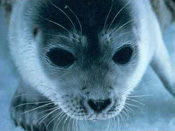Ringed Seal (Phoca hispida)
Status | Taxonomy | Species Description | Habitat | Distribution |
Population Trends | Threats | Conservation Efforts | Regulatory Overview |
Key Documents | More Info
 Ringed Seal (Phoca hispida) Photo: NOAA |
|
Did You Know? · Females construct lairs within the thick ice and give birth in these structures. |
|
Status
ESA Candidate Species - throughout its range
MMPA - Ringed seals, like all marine mammals, are protected under the MMPA.
Taxonomy
Kingdom: Animalia
Phylum: Chordata
Class: Mammalia
Order: Carnivora
Family: Phocidae
Genus: Phoca
Species: hispida
The saimaa seal (Phoca hispida saimensis) is a subspecies of the ringed seal.
Species Description
Ringed seals are part of the "true seal" family Phocidae. The ringed seal is the smallest and most common seal in the Arctic. They have a small head, short cat-like snout, and a plump body. Their coat is dark with silver rings on their back and sides with a silver belly. Their small foreflippers have claws more than 1 inch (2.5 cm) thick that are used to maintain breathing holes through 6.5 ft (2 m) thick ice.
They grow to average lengths of 5 ft (1.5 m) with weights ranging from 110-150 lbs (50-70 kg). Ringed seals live about 25 to 30 years.
They are solitary animals and when hauled out on ice separate themselves from each other by hundreds of yards.
Females reach sexual maturity at 4 years while males do not reach maturity until 7 years old. Males are thought to be monogamous breeders. During the spring breeding season, females construct lairs within the thick ice and give birth in these structures. Females give birth to a single pup in March or April after a 9 month gestation period. Pups are weaned after one month and females usually begin mating in late April.
Ringed seals eat a wide variety of small prey that consists of 72 species of fish and invertebrates. Feeding is usually a solitary behavior and their prey of choice includes mysids, shrimp, arctic cod, and herring. While feeding, ringed seals dive to depths of 35 to 150 ft (10-45 m).
Habitat
Ringed seals reside in arctic waters and are commonly associated with ice floes and pack ice.
Distribution
The ringed seal is found in the Northern Hemisphere with a circumpolar distribution ranging from 35°N to the North Pole. There is only one recognized stock of ringed seals in U.S. waters: the Alaska stock.
Population Trends
The estimated population size for the Alaska stock of ringed seals is 249,000 animals. Currently, the population trend for this stock is unknown.
Threats
Ringed seals are harvested annually by Artic natives for subsistence. Bycatch in fishing gear, such as commercial trawls, is also another threat to ringed seals. Climate change is potentially the most serious threat to ringed seal populations since much of their habitat is dependent upon pack ice.
Conservation Efforts
Ringed seals are considered Low Risk-least concern in the IUCN Red List ![]() of species.
of species.
Regulatory Overview
This species is protected under the Marine Mammal Protection Act of 1972 as amended.
Key Documents
(All documents are in PDF format.)
| Title | Federal Register | Date |
|---|---|---|
| Initiation of Status Review | 73 FR 16617 | 03/28/2008 |
| Stock Assessment Reports | n/a | various |